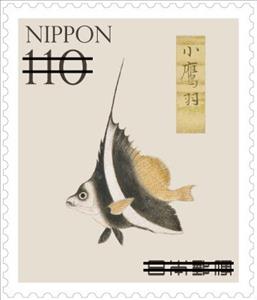Stamp: Record of Nature (Series 5) : Illustrations from Shuurinzu (Japan 2025)
Record of Nature (Series 5) : Illustrations from Shuurinzu (Japan 2025)
22 January (Japan ) within release Record of Nature (Series 5) (2025) goes into circulation Stamp Record of Nature (Series 5) : Illustrations from Shuurinzu face value 110 Japanese yen
| Stamp Record of Nature (Series 5) : Illustrations from Shuurinzu in catalogues | |
|---|---|
| Colnect codes: | Col: JP 2025.01.22-01b |
Stamp is square format.
stamp from mini-sheetAlso in the issue Record of Nature (Series 5) (2025):
- Mini Sheet - Record of Nature (Series 5) : Illustrations from Shuurinzu face value 10*110;
- Stamp - Record of Nature (Series 5) : Illustrations from Shuurinzu face value 110;
- Stamp - Record of Nature (Series 5) : Illustrations from Shuurinzu face value 110;
- Stamp - Record of Nature (Series 5) : Illustrations from Shuurinzu face value 110;
- Stamp - Record of Nature (Series 5) : Illustrations from Shuurinzu face value 110;
- Stamp - Record of Nature (Series 5) : Illustrations from Shuurinzu face value 110;
- Stamp - Record of Nature (Series 5) : Illustrations from Shuurinzu face value 110;
- Stamp - Record of Nature (Series 5) : Illustrations from Shuurinzu face value 110;
- Stamp - Record of Nature (Series 5) : Illustrations from Shuurinzu face value 110;
- Stamp - Record of Nature (Series 5) : Illustrations from Shuurinzu face value 110;
- Stamp - Record of Nature (Series 5) : Illustrations from Shuurinzu face value 110;
Stamp Record of Nature (Series 5) : Illustrations from Shuurinzu it reflects the thematic directions:
Art is a diverse range of human activities in creating visual, auditory or performing artifacts (artworks), expressing the author's imaginative or technical skill, intended to be appreciated for their beauty or emotional power. In their most general form these activities include the production of works of art, the criticism of art, the study of the history of art, and the aesthetic dissemination of art. The oldest documented forms of art are visual arts, which include creation of images or objects in fields including painting, sculpture, printmaking, photography, and other visual media. Architecture is often included as one of the visual arts; however, like the decorative arts, or advertising, it involves the creation of objects where the practical considerations of use are essential—in a way that they usually are not in a painting, for example. Music, theatre, film, dance, and other performing arts, as well as literature and other media such as interactive media, are included in a broader definition of art or the arts. Until the 17th century, art referred to any skill or mastery and was not differentiated from crafts or sciences. In modern usage after the 17th century, where aesthetic considerations are paramount, the fine arts are separated and distinguished from acquired skills in general, such as the decorative or applied arts.
A fish is any member of a group of animals that consist of all gill-bearing aquatic craniate animals that lack limbs with digits. They form a sister group to the tunicates, together forming the olfactores. Included in this definition are the living hagfish, lampreys, and cartilaginous and bony fish as well as various extinct related groups. Tetrapods emerged within lobe-finned fishes, so cladistically they are fish as well. However, traditionally fish are rendered obsolete or paraphyletic by excluding the tetrapods (i.e., the amphibians, reptiles, birds and mammals which all descended from within the same ancestry). Because in this manner the term "fish" is defined negatively as a paraphyletic group, it is not considered a formal taxonomic grouping in systematic biology. The traditional term pisces (also ichthyes) is considered a typological, but not a phylogenetic classification. The earliest organisms that can be classified as fish were soft-bodied chordates that first appeared during the Cambrian period. Although they lacked a true spine, they possessed notochords which allowed them to be more agile than their invertebrate counterparts. Fish would continue to evolve through the Paleozoic era, diversifying into a wide variety of forms. Many fish of the Paleozoic developed external armor that protected them from predators. The first fish with jaws appeared in the Silurian period, after which many (such as sharks) became formidable marine predators rather than just the prey of arthropods. Most fish are ectothermic ("cold-blooded"), allowing their body temperatures to vary as ambient temperatures change, though some of the large active swimmers like white shark and tuna can hold a higher core temperature. Fish are abundant in most bodies of water. They can be found in nearly all aquatic environments, from high mountain streams (e.g., char and gudgeon) to the abyssal and even hadal depths of the deepest oceans (e.g., gulpers and anglerfish). With 33,100 described species, fish exhibit greater species diversity than any other group of vertebrates. Fish are an important resource for humans worldwide, especially as food. Commercial and subsistence fishers hunt fish in wild fisheries (see fishing) or farm them in ponds or in cages in the ocean (see aquaculture). They are also caught by recreational fishers, kept as pets, raised by fishkeepers, and exhibited in public aquaria. Fish have had a role in culture through the ages, serving as deities, religious symbols, and as the subjects of art, books and movies.


